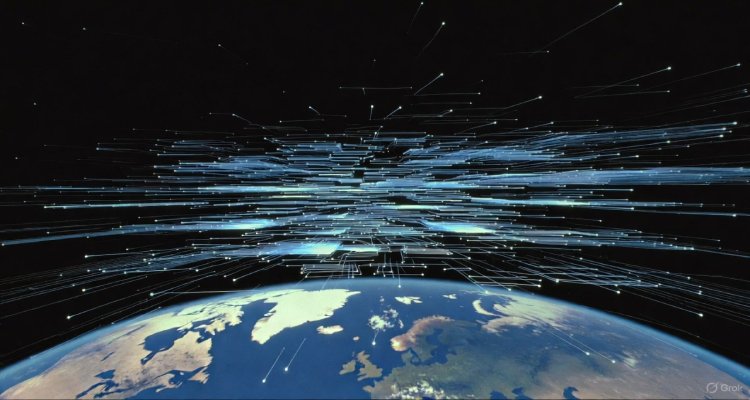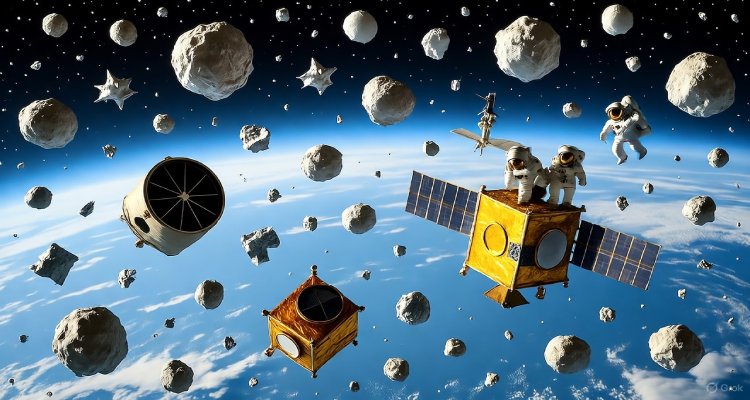Why Space Junk Might Be Humanity’s First Global Disaster
The growing cloud of space debris orbiting Earth threatens satellites, astronauts, and global communications — and could soon trigger humanity’s first true global disaster.
Introduction: A Crisis Floating Above Our Heads
High above the calm blue curve of Earth, chaos is brewing. Millions of fragments — from defunct satellites to shattered rocket parts — zip through orbit at deadly speeds, creating a lethal minefield around our planet. It’s not science fiction. It’s the new frontier of human negligence, and experts warn it might soon spark humanity’s first global disaster.
The debris, known as space junk or orbital debris, is growing faster than we can control. Each collision spawns thousands of new fragments, increasing the risk of a catastrophic chain reaction that could cripple modern life as we know it.
Context & Background: How We Cluttered the Cosmos
Since the dawn of the Space Age in 1957, humanity has launched more than 17,000 satellites. But only a fraction remain functional. The rest — old satellites, booster stages, and mission scraps — orbit Earth as ticking time bombs.
NASA estimates there are over 36,000 pieces of debris larger than 10 centimeters and more than 130 million smaller fragments hurtling through space at up to 17,500 miles per hour. Even a paint chip at that speed can punch through spacecraft shielding.
This floating landfill began as a byproduct of progress — the Cold War space race, satellite internet expansion, and global defense surveillance. But decades of neglect and competition have transformed low-Earth orbit (LEO) into a congested junkyard, one that might soon make space travel nearly impossible.
Main Developments: The Domino Effect Waiting to Happen
Scientists fear a phenomenon called the Kessler Syndrome, proposed by NASA scientist Donald Kessler in 1978. It predicts that once space debris reaches a certain density, collisions will trigger a self-sustaining chain reaction — destroying satellites, spawning new debris, and ultimately trapping humanity under an impassable belt of wreckage.
That scenario is no longer hypothetical.
- In 2009, an inactive Russian satellite collided with an active Iridium communications satellite, creating more than 2,000 trackable fragments.
- In 2021, Russia’s anti-satellite missile test shattered one of its own defunct satellites, producing over 1,500 fragments and forcing astronauts aboard the International Space Station (ISS) to take shelter.
- In 2023, pieces of a Chinese rocket booster re-entered Earth’s atmosphere uncontrolled, scattering debris across villages in Southeast Asia.
These incidents show that space junk isn’t just an orbital problem — it’s a terrestrial one, too.
Expert Insight: A Crisis in Slow Motion
Dr. Moriba Jah, an astrodynamicist at the University of Texas at Austin, calls orbital debris “the pollution problem of the space age.” He explains, “We’re littering Earth’s orbit with no plan for cleanup. If we lose access to space, we lose weather forecasting, GPS, global banking — everything.”
The European Space Agency (ESA) echoes this concern, warning that without intervention, critical satellite networks could fail within decades. Global communications, navigation systems, and even the internet backbone depend on satellites orbiting safely above Earth.
Even Elon Musk’s Starlink network, with its thousands of small satellites, adds complexity to the issue. While SpaceX claims its satellites can deorbit safely, experts fear a single large-scale collision could cripple entire constellations.
Impact & Implications: The Global Fallout
The threat isn’t isolated to one nation — it’s a shared human problem.
If a chain-reaction event like Kessler Syndrome occurs, it could render low-Earth orbit unusable for decades. That means:
- No new satellites for weather tracking or disaster response
- Limited GPS navigation
- Communication blackouts in remote areas
- Billions lost in global trade and finance systems reliant on satellite timing
Worse still, this orbital clutter could block humanity’s ambitions for deep space exploration. Missions to the Moon, Mars, or beyond would be at constant risk from a deadly swarm of man-made shrapnel.
Some countries and private firms are responding. The Japanese startup Astroscale is testing debris-removal technologies using magnetic docking systems, while the ESA’s ClearSpace-1 mission, planned for launch soon, aims to capture and deorbit a defunct satellite part. However, these solutions are expensive and limited in scale.
Conclusion: Cleaning Up Before It’s Too Late
Humanity’s next great environmental challenge isn’t in the oceans or the atmosphere — it’s in orbit. The space above our planet has become an invisible dumping ground for decades of ambition, neglect, and technological haste.
Unless nations collaborate to enforce orbital cleanup and debris prevention, the first global disaster might not come from Earth — but from above it.
As Dr. Jah aptly puts it, “We’re on the verge of losing our access to space. And if we do, the digital world below will collapse with it.”
The question now isn’t whether we can clean up space — it’s whether we’ll act before it’s too late.
Disclaimer: This article is based on publicly available scientific data and expert analysis. It does not represent the views of any government or organization.











